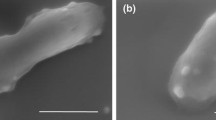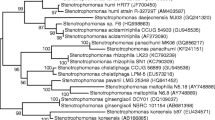Abstract
Cyanobacterial blooms become a serious environmental threat to the freshwater ecosystem, and several physical and chemical methods have been developed for controlling the blooms. In order to develop a biocontrol agent for controlling the blooms, we isolated a bacterial strain R219 that exhibited strong algicidal activity against the dominant bloom-forming species of Microcystis aeruginosa from Lake Tai in China. Based on 16S rDNA sequence analysis we determined the strain R219 to be Pseudomonas aeruginosa by the virtue of its sharing about 99.8% similarity with reference strains in the DNA databases. Biochemical and morphological tests were used to support the accurate identification as that of the bacterium P. aeruginosa. We also tested culture filtrate and ethyl acetate extract of strain R219 and showed both of them exhibited strong algicidal effect on the growth of M. aeruginosa at mid-exponential phase when the R219 filtrate and ethyl acetate extract were applied at various cell densities. Moreover, the P. aeruginosa filtrate showed high potency in removal of the mixed species bloom-forming cyanobacteria collected directly from the Lake Tai. When adding the filtrate of the strain R219 to the mixed-species cyanobacteria, the content of chlorophyll-a of the algae were reduced by as much as 80–90%. Oral acute toxicity assessment for strain R219 demonstrated that all the mice that received the broth or filtrate in doses of 0.5 or 2.0 g kg−1 were alive without any immediate behavioral changes within 14 days of administration of either broth or filtrate. These results indicate that the strain R219 may have potential for a use in controlling the bloom-forming cyanobacteria in freshwater ecosystems.





Similar content being viewed by others
References
Baker KH, Herson DS (1978) Interactions between the diatom Thallasiosira pseudonana and an associated Pseudomonad in a mariculture system. Appl Environ Microbiol 35:791–796
Banin E, Khare SK, Naider F, Rosenberg E (2001) Proline-rich peptide from the coral pathogen Vibrio shiloi that inhibits photosynthesis of Zooxanthellae. Appl Environ Microbiol 67:1536–1541
Caiola GM, Pellegrini S (1984) Lysis of Microcystis aeruginosa (KÜTZ) by Bdellovibrio like bacteria. J Phycol 20(4):471–475
Choi HJ, Kim BH, Kim JD, Han MS (2005) Streptomyces neyagawaensis as a control for the hazardous biomass of Microcystis aeruginosa (Cyanobacteria) in eutrophic freshwaters. Biol Control 33:335–343
Cornelis P (2008) Pseudomonas: genomics and molecular biology, 1st edn. Caister Academic Press, Norwich
Cui Y, Liu L, Huang CY (2005) Progress on platelet physiology at low temperature. J Southeast Univ 24(3):202–206
Dai R, Liu H, Qu J, Ru J, Hou Y (2008) Cyanobacteria and their toxins in Guanting Reservoir of Beijing, China. J Hazard Mater 153(1–2):470–477
Dakhama A, Delanoüe J, Lavoie MC (1993) Isolation and identification of antialgal substances produced by Pseudomonas aeruginosa. J Appl Phycol 5:297–306
Gong LY, Wang XL, Li YB, Zhang CS, Liang SK, Zhu CJ (2004) Isolation and purification of phenazine pigments produced by Pseudomonas aeruginosa and its effects on the growth of red tide organisms. J Fudan Univ 43(4):494–499, 506
Guan YH, Ma J, Lei GY, Liu Y (2008) Isolation, identification and algicidal characteristics of an algicidal bacterium. Acta Scientiae Circumstantiae 28(7):1288–1293
Gustafsson S, Hultberg M, Figueroa RI (2009) On the control of HAB species using low biosurfactant concentrations. Harmful Algae. doi:10.1016/j.hal.2009.04.002
Imamura N, Motoike I, Shimada N, Nishikori M, Morisaki H, Fukami H (2001) An efficient screening approach for anti-microcystis compounds based on knowledge of aquatic microbial ecosystem. J Antibiot 54(7):582–587
Inskeep WP, Bloom PR (1985) Extinction coefficients of Chlorophyll a and b in N, N-dimethylformamide and 80% acetone. Plant Physiol 77:483–485
Jeong SY, Ishida K, Ito Y, Okada S, Murakami M (2003) Bacillamide, a novel algicide from the marine bacterium, Bacillus sp. SY-1, against the harmful dinoflagellate, Cochlodinium polykrikoides. Tetrahedron Lett 44:8005–8007
Jung SW, Lee JH, Han MS (2008) Algicidal effect of Pseudomonas fluorescens against Stephanodiscus Hantzschii (Bacillariophyceae) during winter freshwater blooms: Biological impact of algicidal activity in mesocosms. J Biotechnol 136(S1):S636
Kang YH, Kim BR, Choi HJ, Seo JG, Kim BH, Han MS (2007) Enhancement of algicidal activity by immobilization of algicidal bacteria antagonistic to Stephanodiscus hantzschii (Bacillariophyceae). J Appl Microbiol 103(5):1983–1994
Kang YK, Cho SY, Kang YH, Katano T, Jin ES, Kong DS, Han MS (2008) Isolation, identification and characterization of algicidal bacteria against Stephanodiscus hantzschii and Peridinium bipes for the control of freshwater winter algal blooms. J Appl Phycol 20:375–386
Kim JD, Kim B, Lee CG (2007) Alga-lytic activity of Pseudomonas fluorescens against the red tide causing marine alga Heterosigma akashiwo (Raphidophyceae). Biol Control 41(3):296–303
Lee SO, Kato J, Takiguchi N, Kuroda A, Ikeda T, Mitsutani A, Ohtake H (2000) Involvement of an extracellular protease in algicidal activity of the marine bacterium Pseudoalteromonas sp. strain A28. Appl Environ Microbiol 66(10):4334–4339
Li MG, Liu J, Pan WB, Zhang HY (2007) Primary report on the growth character of three algae-lysing bacteria. Guangzhou Environ Sci 22(2):1–3, 30
Liu YB, Chen WM, Fan CX, Ji J, Gao XY, Chen YW (1998) Ecological simulation of blue algal bloom in Meiliang Bay, Taihu lake and analysis of its harness strategies. J Lake Sci 10(4):53–58
Liu CH, Chen X, Liu TT, Lian B, Gu YC, Caer V, Xue YR, Wang BT (2007) Study of the antifungal activity of Acinetobacter baumannii LCH001 in vitro and identification of its antifungal components. Appl Microbiol Biotechnol 76:459–466
Manage PM, Kawabata Z, Nakano S (2001) Dynamics of cyanophage-like particles an algicidal bacteria causing Microcystis aeruginosa mortality. Limnology 2:73–78
Mayali X, Doucette GJ (2002) Microbial community interactions and population dynamics of an algicidal bacterium active against Karenia brevis (Dinophyceae). Harmful Algae 1:277–293
Mitsutani A, Yamasaki I, Kitaguchi H, Kato J, Ueno S, Ishida Y (2001) Analysis of algicidal proteins of a diatom-lytic marine bacterium Pseudoalteromonas sp. strain A25 by two-dimensional electrophoresis. Phycologia 40(3):286–291
Mu RM, Fan ZQ, Pei HY, Yuan XL, Liu SX, Wang XR (2007) Isolation and algae-lysing characteristics of the algicidal bacterium B5. J Environ Sci 19:1336–1340
Oberholster PJ, Botha AM, Grobbelaar JU (2004) Microcystis aeruginosa: source of toxic microcystins in drinking water. Afr J Biotechnol 3:159–168
Paul SB, Jinnque R, Haim BG (1979) Bacterial suppression of Qhlorella by hydrozylamine production. Water Res 13(1):267–273
Ross C, Santiago-Vazquez L, Paul V (2006) Toxin release in response to oxidative stress and programmed cell death in the cyanobacterium Microcystis aeruginosa. Aquatic Toxicol 78:66–73
Roth PB, Twiner MJ, Mikulski CM, Barnhorst AB, Doucette GJ (2008) Comparative analysis of two algicidal bacteria active against the red tide dinoflagellate Karenia brevis. Harmful Algae 7(5):682–691
Ryan KJ, Ray CG (2004) Sherris medical microbiology, 4th edn. McGraw-Hill Medical Publishing Division, New York
Saiki RK, Gelfand DH, Stoffel S, Scharf SJ, Higuchi R, Horn GT, Mullis KB, Erlich HA (1988) Primer-directed enzymatic amplification of DNA with a thermostable DNA polymerase. Science 239:487–491
Schoemann V, Becquevort S, Stefels J, Rousseau V, Lancelot C (2005) Phaeocystis blooms in the global ocean and their controlling mechanisms: a review. J Sea Res 53(1–2):43–66
Shi SY, Liu YD, Shen YW (2006) Lysis of Aphanizomenon xosaquae (Cyanobacterium) by a bacterium Bacillus cereus. Biol Control 39:345–351
Sigee DC, Glenn R, Andrews MJ, Bellinger EG, Butler RD, Epton HAS, Hendry RD (1999) Biological control of cyanobacteria: principles and possibilities. Hydrobiologia 396:161–172
Su JQ, Yang XR, Zheng TL, Tian Y, Jiao NZ, Cai LZ, Hong HS (2007) Isolation and characterization of a marine algicidal bacterium against the toxic dinoflagellate Alexandrium tamarense. Harmful Algae 6:799–810
Takenaka S, Watanabe MF (1997) Microcystin LR degradation by Pseudomonas aeruginosa alkaline protease. Chemosphere 34(4):749–757
van Rijssel M, Janse I, Noordkamp DJB, Gieskes WWC (2000) An inventory of factors that affect polysaccharide production by Phaeocystis globosa. J Sea Res 43:297–306
Wang XL, Gong LY, Liang SK, Han XR, Zhu CJ, Li YB (2005) Algicidal activity of rhamnolipid biosurfactants produced by Pseudomonas aeruginosa. Harmful Algae 4(2):433–443
Wang H, Liu ZP, Wei W, Zhao GM, Liu XG (2008a) Studies of separation and appraisal of an algae-lysing bacteria and its dissolved algae matter. China Environ Sci 28(5):461–465
Wang H, Liu ZP, Mehta SK, Zhao GM (2008b) Algicidal activity of Achromobacter sp. (strain YZ) isolated from yellow sea: An assessment with bloom causing cyanobacterium Microcystis aeruginosa. J Biotechnol 136(S1):S563
Yamamoto Y, Suzuki K (1977) Ultrastructural studies on lysis of blue green algae by bacterium. J Gen Appl Microbiol 23(3):285–295
Yamamoto Y, Kouchiwa T, Hodoki Y (1998) Distribution and identification of actinomycetes lysing cyanobacteria in a eutrotrophic lake. J App Phycol 10(2):391–397
Yoshikawa K, Adachi K, Nishijima M, Takadera T, Tamaki S, Harada K, Mochida K, Sano H (2000) β-Cyanoalanine production by marine bacteria on cyanide-free medium and its specific inhibitory activity toward cyanobacter. Appl Environ Microbiol 66(2):718–722
Zhao CP, Pu YP, Yin LH, Lv XW, Li XN (2005) Isolation and algicidal effect of a lytic microcystis bacterium from Taihu Lake. J Southeast Univ 35(4):602–606
Zurawell RW, Chen H, Burke JM, Prepas EE (2005) Hepatotoxic cyanobacteria: a review of the biological importance of microcystins in freshwater environments. J Toxicol Environ Health Part B: Critical Reviews 8:1–37
Acknowledgments
This work was supported by the National Basic Research Program of China (2008CB418004) and the Special Program for Taihu Lake of Jiangsu Natural Science Foundation (BK2007739), for which the authors are thankful. Special thanks for Professor Lubomir Sokolov who made a lot of valuable comments during the manuscript preparation.
Author information
Authors and Affiliations
Corresponding authors
Rights and permissions
About this article
Cite this article
Ren, H., Zhang, P., Liu, C. et al. The potential use of bacterium strain R219 for controlling of the bloom-forming cyanobacteria in freshwater lake. World J Microbiol Biotechnol 26, 465–472 (2010). https://doi.org/10.1007/s11274-009-0192-2
Received:
Accepted:
Published:
Issue Date:
DOI: https://doi.org/10.1007/s11274-009-0192-2




